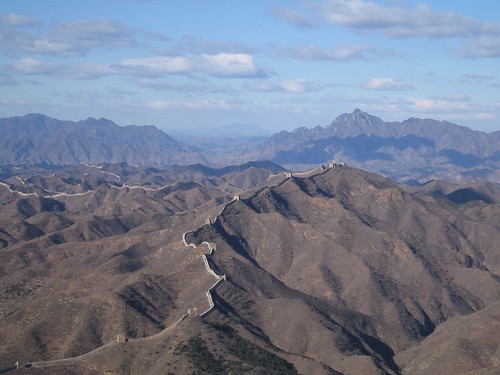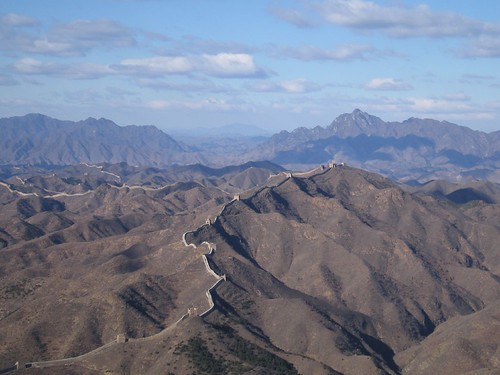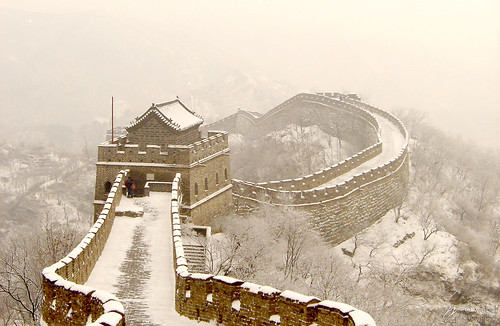Subsequently, the Northern and Southern Dynasties (420-589) coexisted. The dynasties of Song, Qi, Liang, and Chen, the Southern Dynasty (420-589), took Jiangkang (present Nanjing City of Jiangsu Province) as their capital. The dynasties of the Northern Wei, the Eastern Wei, the Western Wei, the Northern Qi, and the Northern Zhou were called the Northern Dynasty (386-581). During this period, the dynasties of the Northern Wei, the Eastern Wei, the Northern Qi, and the Northern Zhou had the Great Wall built and extended.
Great Wall of the Northern Wei Dynasty (386-534)
Tuoba Gui, the chieftain of Xianbei people, the most important and largest nomadic tribes of the steppe region north of China during the Northern and Southern Dynasties, established the Wei Dynasty in 386, later called the Northern Wei. At that time, its northern Rouran people, a nomadic tribe living north of the Northern Wei, became increasingly powerful. To thwart their advance, in 423 the Northern Wei Dynasty built about 1,000 kilometers (621 miles) of the Great Wall to its northern boundary and set up garrisons to prevent invasion by the Rouran.
This section of the Great Wall started from Chicheng County of Hebei Province, through the north of Shanxi Province and ended in Wuyuan County of Inner Mongolia. Emperor Taiwudi, ruler at the height of Northern Wei military strength, ended the unification war at the Yellow River Valley, defeated his powerful enemy, the Rouran, and established six important garrisons north of the Great Wall to protect Pingcheng City (present Datong City), capital of the Northern Wei.
The Northern Wei also built the inner wall (Sai Wei), an earth wall lower and thinner than the Great Wall, to supplement the Great Wall. The Sai Wei was also built to protect Pingcheng City. It started from present Shanxi Province, along the boundary of Shanxi and Hebei provinces and reached Tianzhen County of Shanxi Province, circled Datong City and ended at the east bank of the Yellow River. It stretched for about 500 kilometers (311 miles) long.
Great Wall of the Eastern Wei Dynasty (534-550)
The Northern Wei divided into Eastern and Western Wei. To prevent intrusion by the Rouran, in 543 the Eastern Wei built a section of the Great Wall from today's Jingle County to Chunyang County of Shanxi Province, stretching about 75 kilometers (47 miles). While not very long; it is the passage through which northern nomadic peoples entered China. The Eastern Wei built this section of the Great Wall to consolidate the northern boundary and to prevent intrusion by nomadic people.
Great Wall of the Northern Qi Dynasty (550-577)
The Northern Qi Dynasty was founded after defeat of the Eastern Wei in 550. During the short period of reign, the dynasty area was frequently invaded by northern nomadic peoples such as the Rouran, Turkic, and Qidan, and was threatened by Western Wei and Northern Zhou. So the Northern Qi rebuilt the Great Wall many times.
During 552, the first part of the Great Wall of the Northern Qi was built to prevent invasion by the Western Wei. This section ran south to north, from today's Lishi County to Shuoxian County of Shanxi Province, stretching about 200 kilometers (124 miles).
Turkic people of the Mongolian Plateau became increasingly powerful, establishing the Turkic Dynasty during the reign of the Northern Qi., often invading the northern boundary of the Northern Qi. So the Northern Qi had to accelerate its pace in the construction of the Great Wall. A section of 450 kilometers (279 miles) was built in 555 starting from the south gate of present Juyongguan Pass and ending in Datong of Shanxi Province at the west.
Not only were two sections of the Great Wall built in 552 and 555, but during 556 a new section was built eastwards reaching Shanhaiguan Pass. The whole Great Wall was then about 1,500 kilometers (932 miles) long, which was longer than those of former dynasties except Qin and Han.
great wall of china

great wall of china

In 557 a defense line was built inside the Great Wall. The section started east of Pianguan Pass in Shanxi Province, passing the eastern Yanmenguan Pass, and Pingxingguan Pass and then reaching Xiaguan Pass of Shanxi Province. The other section, starting from Niangziguan Pass, passing Malingguan Pass and ending at Huangyangguan Pass no longer exists; only some relics remain.
In 563 another section of the Great Wall was built along Mt. Taihangshan at the junction of Shanxi and Hebei Provinces. Some parts remain at the top of Mt. Taihangshan. A well-preserved section ran from west of Longquanguan Pass to west of Xiakou town, Jianping County of Hebei.
Because in 563 Turkic people launched two hundred thousand soldiers to destroy the Great Wall and prepared to invade Pingcheng City, the Northern Qi extended the Great Wall of the Eastern Wei to Yanmenguan Pass in 565 and mended the inner Great Wall built in 557. In addition, a section of the Great Wall was extended from Xiaguan Pass of Shanxi Province to its east end, Juyongguan Pass. A section between Juyongguan Pass and Shanhaiguan Pass was rebuilt.
Great Wall of the Northern Zhou Dynasty (557-581)
By defeating the Western Wei, the Northern Zhou Dynasty was established in 557. At its height, it defeated the Northern Qi in 577 and unified the north of China. Meanwhile, the Turkic people north of the Northern Zhou became stronger and frequently intruded into Northern Zhou areas. Emperor Jingdi had the Great Wall of the Northern Qi renovated in 579.
great wall of china
